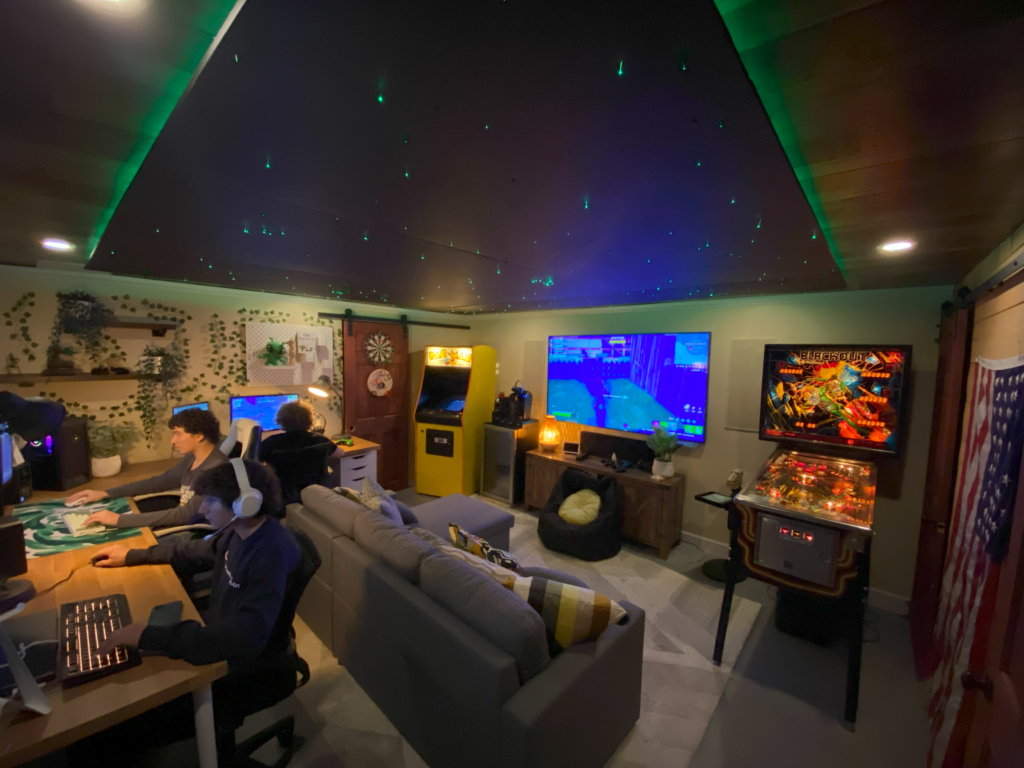Gaming is no longer just a hobby—it’s a lifestyle. As gaming culture has exploded globally, more and more enthusiasts are looking to elevate their experience beyond a simple desk and monitor setup. Enter the custom gaming room—a personalized, immersive space designed specifically for performance, comfort, and aesthetic appeal. Whether you’re a casual player or a competitive streamer, the right environment can completely transform how you game.
In this guide, we’ll walk through everything you need to know to build a custom gaming room from scratch. From choosing the right space to picking lighting, seating, soundproofing, and gear, we’ve got you covered with practical tips and inspiration.
Finding the Right Space for Your Custom Setup
Before you start buying RGB lights and ultra-wide monitors, you’ll need to identify the right space in your home. Ideally, this should be a room where distractions are minimal and you have enough control over lighting and sound. Some top options include:
- A spare bedroom
- A basement or loft
- A home office or den
- A converted garage
It’s crucial that your chosen space allows for proper ventilation, room for movement, and ideally, some privacy. Gamers who stream or record content will also benefit from a space that can be easily soundproofed.
Layout Planning and Theme Inspiration
Start with a Concept
One of the most exciting parts of building a custom gaming room is choosing a theme. This isn’t just about how it looks—it also guides your layout and purchasing decisions. Some popular themes include:
- Futuristic Cyberpunk: Neon lighting, dark walls, metal textures
- Minimalist: Clean lines, neutral tones, clutter-free
- Retro Arcade: Bright colors, vintage game posters, retro consoles
- Fantasy/Medieval: Dark wood, fantasy art, RPG game memorabilia
- Esports Arena: Branding, team colors, LED walls
Once you’ve picked a theme, sketch your layout or use software like SketchUp or Roomstyler to visualize furniture and gear placements. Position your desk, monitor(s), and chair first, and build everything else around your central command center.
Gaming Desk and Monitor Setup
Choose the Right Desk
A good gaming desk is the heart of your setup. Look for something that supports:
- Multiple monitors
- Cable management
- Adjustable height (if you prefer standing desks)
- Wide surface area for accessories and space to move
L-shaped or U-shaped desks are ideal if you have multiple systems or want to separate streaming gear from your main setup.
Monitor Configuration
Your monitor setup will depend on your gaming style:
- Single Ultra-Wide Monitor: Great for immersive single-player games.
- Dual Monitors: Ideal for multitasking, stream management, and casual gaming.
- Triple Monitors: Perfect for simulation games or competitive multitasking.
Mounting monitors on adjustable arms not only frees up desk space but also allows you to customize viewing angles.
Lighting That Sets the Mood
Lighting can make or break the mood in your custom gaming room. A combination of practical and ambient lighting gives you the best results.
RGB and LED Lights
These are gamer staples for a reason. Use LED strips behind monitors, under desks, or along ceiling borders to create color effects that sync with your gameplay. Popular brands like Nanoleaf or Govee offer smart lighting panels that change color in response to screen activity.
Overhead and Task Lighting
Install dimmable overhead lighting so you can control brightness during long sessions. Pair that with adjustable desk lamps for tasks that require more visibility, like writing or reading game guides.
Natural Light Considerations
If your room has windows, invest in blackout curtains or smart blinds to control glare. Some gamers prefer a pitch-black environment, while others find a bit of natural light energizing during daytime sessions.
Ergonomics and Comfort
Gaming for hours can take a toll on your body if you’re not careful. Invest in ergonomic furniture to maintain posture and reduce fatigue.
Gaming Chairs vs. Office Chairs
High-end gaming chairs offer lumbar support, adjustable arms, and recline features. But don’t overlook ergonomic office chairs—they often offer better long-term support, especially for hybrid work-and-play setups.
Footrests and Arm Supports
Small additions like footrests or wrist cushions can drastically improve comfort. If you use a keyboard and mouse extensively, padded mouse pads and gel wrist rests reduce strain.
Soundproofing and Acoustics
Sound is just as important as visuals in a gaming experience. If you live with others—or don’t want to disturb your neighbors—soundproofing your custom gaming room is essential.
Materials and Techniques
- Acoustic Panels: Place on walls to absorb noise and reduce echo.
- Carpet or Rugs: These reduce noise bounce and footsteps.
- Door Sweeps and Weatherstrips: Seal gaps in doors to block sound leaks.
- Heavy Curtains: These help control both light and sound.
Sound Systems and Headsets
A good gaming headset with surround sound offers directional audio cues for competitive play. If you prefer speakers, consider a surround sound system with subwoofers and satellite speakers, properly spaced for an immersive effect.
Cable Management and Clean Aesthetics
Few things ruin a beautiful gaming room like tangled wires. Invest in cable management tools like:
- Under-desk trays
- Velcro cable ties
- Raceway covers
- Cable sleeves
Use zip ties to bundle wires and attach them to the underside of your desk or along baseboards. Wireless accessories like keyboards, mice, and headsets also reduce clutter.
Must-Have Tech and Accessories
To truly elevate your custom gaming room, consider adding:
- Streaming Gear: Ring lights, DSLR camera, capture cards, green screen
- Voice Assistants: Smart speakers or AI assistants for hands-free control
- Mini Fridge: Because hydration and snacks are important!
- Display Shelves: For collectibles, trophies, or themed decorations
- Wall Mounts: For controllers, headphones, and even your console
- Cable Charging Stations: Keep controllers and devices powered up
You can also add cool extras like a digital clock display, LED floor lamps, or a starry sky projector for that “wow” factor.
Creating a Dual-Purpose Space
Many gamers work from home, so creating a dual-purpose setup is increasingly common. If this applies to you, consider dividing your room visually:
- Use a partition or rug to separate gaming and work areas
- Set up a second monitor facing away from the primary setup
- Use different lighting presets for “work mode” vs. “game mode”
This mental separation helps maintain focus and prevents burnout.
Maintaining and Updating Your Setup
Once your custom gaming room is complete, it’s important to maintain it. Clean your gear regularly, check cable ties, and monitor for overheating issues. Technology evolves fast, so leave room in your layout for future upgrades. Whether it’s a new GPU, VR system, or display panel, flexibility in your setup keeps it future-ready.
Why a Custom Gaming Room Matters
A custom gaming room isn’t just about aesthetics—it enhances your entire gaming experience. From comfort and immersion to organization and mental clarity, a well-designed space makes a significant difference. Whether you’re grinding through late-night raids or just relaxing with your favorite indie title, having a room built just for gaming creates an emotional connection to your hobby.
A thoughtfully crafted gaming space also serves as a social hub. It can be a place to stream, to invite friends over for couch co-op, or to simply unwind after a long day. The ambiance you create directly affects how much enjoyment and performance you get out of your time spent gaming.
Final Thoughts
Designing a custom gaming room is both an exciting project and a rewarding investment. It’s where passion meets practicality. It doesn’t matter whether you have a small nook or a large dedicated space—what matters is creating an environment that reflects your gaming identity and supports your comfort and performance.
So take your time, plan wisely, and enjoy the process. Once it all comes together, you’ll realize it wasn’t just about creating a room. You built your own personal universe—one click, one color, one cable at a time.
FAQs
How much does it cost to build a custom gaming room?
It depends on the size, components, and quality you choose. A basic setup can start at $500–$1,000, while high-end builds can go well above $5,000.
Can a custom gaming room improve my gameplay?
Yes! Better ergonomics, lighting, and reduced distractions can help you focus and perform better during sessions.
Do I need a big space for a custom gaming room?
Not at all. Even a small corner or closet can be converted into a personalized gaming zone with the right planning.
How do I soundproof my gaming room?
Use acoustic foam panels, rugs, door seals, and heavy curtains to block and absorb noise effectively.
Is RGB lighting necessary?
Not necessary, but it enhances mood, visibility, and can sync with your gameplay for added immersion.

